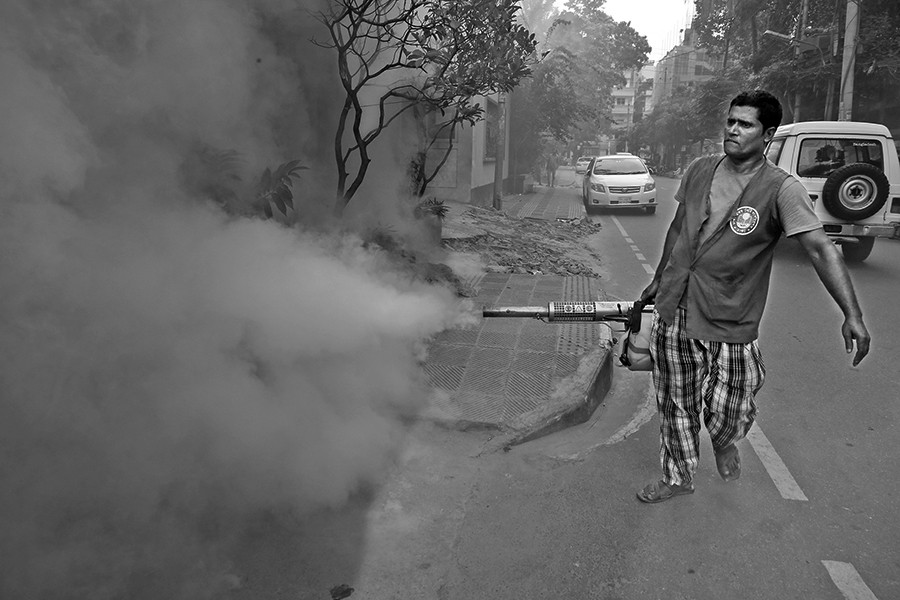The authorities have spent nearly half a billion in the outgoing fiscal year only on killing mosquitoes in Dhaka, but the number of the insect-borne dengue infections has started rising in the beginning of the monsoon - the peak season for the disease.
Relatives of the patients have pointed the finger at the two city corporations in the capital, but they refute the allegation of insincerity and cite slack vigil by the citizens.
Until June 15 this year, as many as 486 people have been diagnosed with dengue in Bangladesh, two of whom have died, according to the disease control section at the Directorate General of Health Services.
The figure shot up by 72 in two days after that day. It was 428 until June 15 last year, including three fatalities.
Disease control officials at the health directorate say the number of dengue patients started rising in early June. Most of the cases are reported in Dhaka, reports bdnews24.
Rainy season is the peak period for the Aedes mosquitoes that bear dengue fever, chikungunya, Zika fever, Mayaro, and yellow fever viruses, DGHS Director (Disease Control) Dr Sanya Tahmina said while speaking about the reason behind the rise in dengue patients.
Earlier in May, researchers at the DGHS’s disease control wing said they found the number of Aedes mosquito larvae higher than the expected level at 15 wards under Dhaka South City Corporation and seven under Dhaka North City Corporation.
The researchers had feared a rise in Aedes mosquito-borne diseases ahead of the monsoon and their concerns have now been proved true.
Crowds At Hospitals On The Rise
The number of dengue patients at different hospitals in Dhaka has started to rise.
Holy Family Red Crescent Medical College Hospital has opened a separate ward to treat children affected by the dengue infection.
Officials said nine children with dengue were admitted only on Saturday last.
On Monday, seven children were being treated at the ward.
Doctor LE Fatmi, head of the hospital’s paediatric department, said up to 20 children got admitted a day this year, which is far more in number and extent than last year.
“We are getting more dengue patients with haemorrhagic and shock syndrome this year. About 50 per cent of the children being treated here now are suffering from dengue,” the doctor said.
Some of the child patients needed to be transferred to other hospitals for better medicare as the Holy Family hospital does not have paediatric intensive care unit (PICU), according to Dr Fatmi.
“Two children who suffered shock had to be referred to other hospitals. Both died later,” the physician said.
“Authorities Don’t Spray Insecticide”
Abdur Rahman, a two and a half years old toddler, was one of the dengue patients at the Holy Family hospital.
His grandfather Motiur Rahman Shikder, retired government official, blamed the city authorities for the mosquito menace.
“I live at Kathalbagan. Mosquito trouble is huge there, but they (authorities) don’t spray insecticide there much. They used to come sometimes before summer, but I haven’t seen anyone in past one and a half months,” he said.
Relatives of Shoshthi Ghosh, an 11-year-old from Old Dhaka’s Chankharpool, had the similar complaints.
“Tell your mayor to run fogging programme in our area properly. Our child is at the crossroads of life and death now after being bitten by mosquito,” his aunt Seema Ghosh said.
Aziz Hashan from Eskaton was taking care of his boy to the hospital. He, too, said he did not see much activity to control mosquito in his area.
What Authorities Say
Facing the barrage of allegations brought by the citizens, Dhaka North and South City Corporation officials say they work ‘sincerely’ to control mosquito.
DSCC Chief Health Officer Md Sharif Ahmed, a brigadier general, claimed dengue cases have not reached the alarming level just yet.
The city corporation was conducting awareness programmes because Aedes mosquito generally breeds inside homes, according to Sharif.
DNCC Chief Health Officer Mominur Rahman Mamun, also a brigadier general, warned about the source of Aedes mosquito.
“Our workers can’t always reach places like open water tanks, reserved water in under-construction buildings, water gathered under lifts, where most Aedes mosquitos breed. The citizen awareness must be raised about these areas,” he said.


